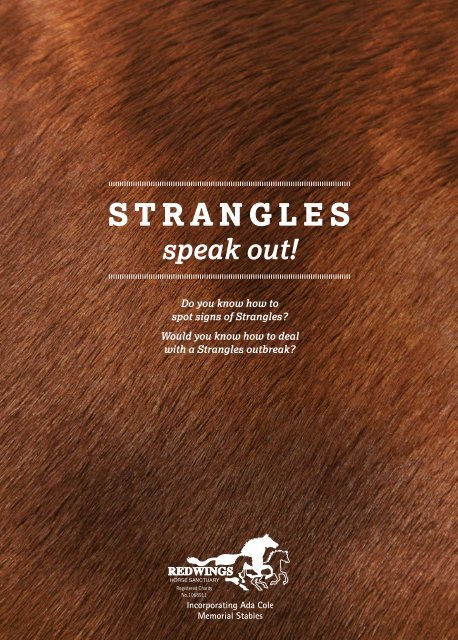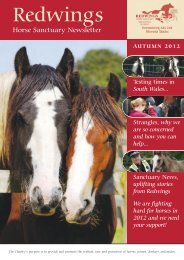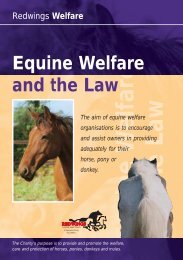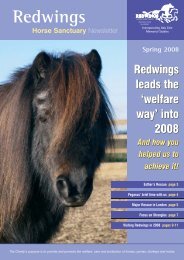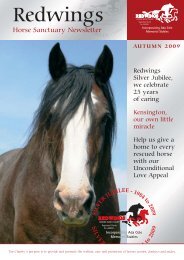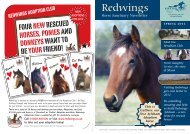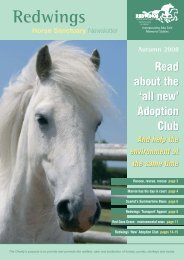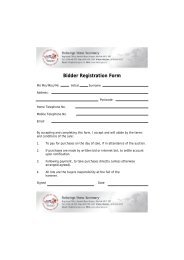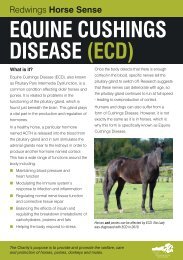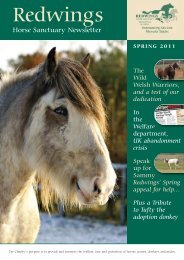STRANGLES - Redwings
STRANGLES - Redwings
STRANGLES - Redwings
You also want an ePaper? Increase the reach of your titles
YUMPU automatically turns print PDFs into web optimized ePapers that Google loves.
<strong>STRANGLES</strong><br />
speak out!<br />
Do you know how to<br />
spot signs of Strangles?<br />
Would you know how to deal<br />
with a Strangles outbreak?<br />
<strong>Redwings</strong> guide to Strangles. Page 1
Using this guide<br />
Strangles outbreaks are common. Any horse is at risk of<br />
contracting the disease unless steps are taken to prevent it.<br />
This guide gives all the information needed for you to understand Strangles, spot the signs<br />
and prevent an outbreak. It contains a checklist of everything you need to set up a quarantine<br />
area and has a quarantine protocol which can be circulated to everybody at your yard.<br />
Part One<br />
KNOW <strong>STRANGLES</strong><br />
To help ditch the Strangles stigma, we have included a poster in this pack for you to<br />
display at your yard. We hope that this will get horse owners talking about the disease<br />
and encourage yards to have a protocol in place to stop the spread and deal with it<br />
effectively if the worst does happen.<br />
Part One<br />
KNOW <strong>STRANGLES</strong><br />
Page 3<br />
About <strong>Redwings</strong><br />
Part Two<br />
SPOT <strong>STRANGLES</strong><br />
Page 4<br />
Part Three<br />
PREPARE FOR <strong>STRANGLES</strong><br />
Page 6<br />
Part Four<br />
PREVENT <strong>STRANGLES</strong><br />
Page 9<br />
<strong>Redwings</strong> Horse Sanctuary was established in 1984 and works across<br />
the UK to provide and promote the welfare, care and protection of<br />
horses, ponies, donkeys and mules. Its work has three main themes<br />
– rescue and rehabilitation, specialist sanctuary care and prevention<br />
through education.<br />
<strong>Redwings</strong> currently cares for more than 1,200 horses, ponies<br />
and donkeys that no longer have a working life but retain<br />
a quality of life. Those with the potential for a working life<br />
are re-homed through the charity’s Guardianship scheme<br />
and currently around 500 horses and ponies are enjoying<br />
active lives in Guardian homes across the East of England.<br />
Part Five<br />
IF IT HAPPENS…<br />
Page 12<br />
Part Six<br />
AFTER RECOVERY…<br />
Page 14<br />
What is Strangles?<br />
Strangles is the most commonly diagnosed equine<br />
infectious disease in the world. It is a highly contagious<br />
infection of the upper respiratory tract (nose and throat).<br />
It can cause large abscesses, prevent swallowing and<br />
restrict breathing.<br />
Like many diseases, prevention is better than cure.<br />
Strangles is both painful and distressing for the horse.<br />
Infected horses are at risk of serious complications,<br />
including death.<br />
Why should I be concerned?<br />
Strangles outbreaks are on the rise. This could be<br />
due to the increasing movement of horses around<br />
the country – in particular horses of lower value that<br />
often end up at market. Markets and sales are great<br />
harbouring grounds for the disease.<br />
Not only is it painful and distressing for sufferers,<br />
a large outbreak at a livery yard can cause serious<br />
financial loss.<br />
Although many of the horses rescued by <strong>Redwings</strong> are<br />
suffering with Strangles, it is not always associated<br />
with poor welfare standards. It can happen to anyone<br />
– even the most responsible owner – simply through a<br />
stroke of bad luck. This is why it is vital to be prepared.<br />
Should I keep quiet if my horse<br />
shows signs of Strangles?<br />
No! Although it’s highly irresponsible, many owners do<br />
keep quiet if their horse catches Strangles. Because of<br />
its contagious nature, Strangles has a very unhelpful<br />
stigma attached to it. Owners may feel that they will<br />
be ostracized by others on their yard if they speak out.<br />
This hinders a quick diagnosis as well as the effective<br />
control of the spread of the disease.<br />
A responsible owner will speak out about the disease,<br />
and a responsible yard manager will have a protocol in<br />
place to deal with it.<br />
Our aim is to give you the information and tools you<br />
need to protect your horse and others on your yard.<br />
The key to success is preparation, prompt action,<br />
and a co-ordinated effort from everyone involved.<br />
This pack includes:<br />
• How to spot Strangles<br />
• How to prepare for an outbreak<br />
• How to prevent an outbreak<br />
• What to do during an outbreak<br />
• What to do after an outbreak<br />
Reading this information could not only save your horse<br />
and others from a serious and potentially fatal disease,<br />
but it could also save you a considerable amount of<br />
time and money.<br />
<strong>Redwings</strong> relies entirely on public<br />
donations and receives no government<br />
funding. To learn more,<br />
telephone 0870 040 0033<br />
or visit www.redwings.co.uk.<br />
It could happen to you<br />
<strong>Redwings</strong> guide to Strangles. Page 2<br />
<strong>Redwings</strong> guide to Strangles. Page 3
Part Two<br />
SPOT <strong>STRANGLES</strong><br />
Benny may look innocent,<br />
but was in fact a Strangles carrier.<br />
He had no symptoms except for<br />
intermittent nasal discharge.<br />
How serious is Strangles?<br />
Strangles is a very unpleasant disease for your horse to<br />
go through. It will be exhausting and upsetting to deal<br />
with if you are not prepared.<br />
There is at least a 10% risk of further complications<br />
such as ‘bastard Strangles’ where the infection spreads<br />
to other parts of the body and is almost always fatal,<br />
or Purpura Haemorrhagia caused by a complication<br />
within the immune system as it fights the Strangles<br />
bacteria causing damage to blood vessels around the<br />
body. This leads to severe swelling in the limbs, head<br />
and other areas of the equine’s body.<br />
Lymph node swelling<br />
What are the symptoms?<br />
Early signs could be any one of the following:<br />
• Sore throat – shown by loss of appetite, difficulty<br />
eating, or difficulty extending the head<br />
• Lymph node swelling (area where head<br />
and neck join)<br />
• Depression<br />
• Fever (temperature above 38.5C)<br />
• A cough<br />
Advanced signs:<br />
• Thick yellow nasal discharge<br />
• Abscesses on the side of the head,<br />
on the throat, or under the jaw<br />
Atypical Strangles symptoms<br />
• Mild short term fever<br />
• Mild clear nasal discharge<br />
• No abscess formation<br />
It’s important to know your horse’s vital signs<br />
(temperature, pulse, respiration rate) to help spot when<br />
something is wrong.<br />
Vital Signs:<br />
Temperature – 100–100F (38C)<br />
Pulse – 32–42 beats per minute<br />
Respiration rate – 8–14 breaths per minute<br />
These vary between horses, so make a note of<br />
your horse’s vital signs over the course of a week<br />
and keep a record.<br />
Some of these clinical signs are also signs of other<br />
diseases (e.g. nasal discharge is a sign of a dust<br />
allergy), so it is important to call a vet straight away<br />
to get an accurate diagnosis. It could be another<br />
disease that will have less impact on your yard. Or, if<br />
it is Strangles, an early diagnosis gives a much better<br />
prospect of a quick recovery.<br />
How is it passed on?<br />
Strangles is not airborne. It can be passed through<br />
direct contact with an infected horse or indirectly<br />
through sharing water, feed buckets, equipment,<br />
pasture, cars travelling from one site to another, or a<br />
human passing the bacteria on their clothing or skin.<br />
It normally takes between 7 and 14 days between<br />
contact with the bacteria and symptoms showing.<br />
I’ve heard that some horses can have<br />
Strangles and not show symptoms?<br />
Around 10% of horses that have suffered with Strangles<br />
in the past will continue to carry Strangles bacteria in<br />
their guttural pouches (air chambers at the top of the<br />
neck) without showing any clinical signs of disease.<br />
These horses are known as ‘carriers’.<br />
Carriers may have occasional nasal discharge, which<br />
could go unnoticed or is thought to be something else.<br />
This is another reason why you must speak to a vet if<br />
you notice anything different about a horse, such as a<br />
small period of nasal discharge.<br />
A carrier will shed bacteria during increased periods<br />
of stress – such as moving to a new home, or ill health<br />
– and pass Strangles on to other horses. You may not<br />
know your horse is a carrier until this has happened.<br />
The newly infected horse will need to be isolated, and<br />
it is important that any horse that has been in contact<br />
with it is isolated too, even if they are not showing any<br />
symptoms, so you can identify the carrier.<br />
Carriers can be treated and go on to live happy lives.<br />
Are all horses at risk? I’ve heard that<br />
some become immune once they’ve had it.<br />
All horses are at risk of Strangles. Young, old, and<br />
horses with weaker immune systems are especially<br />
at risk. Horses that have previously had the disease<br />
may form a certain level of immunity, but this is highly<br />
variable between horses and is not worth the risk.<br />
Is there a Strangles vaccination available?<br />
Thick yellow nasal discharge<br />
Abscesses<br />
Strangles is passed on<br />
through physical contact<br />
There is a vaccination available, but it is best to discuss<br />
with your vet whether a vaccination programme is right<br />
for you. The vet will assess wether your horse is<br />
‘at risk’ of Strangles. Like many vaccines, it does not<br />
completely rule out the risk of getting the disease and<br />
is not a replacement for good yard practices.<br />
<strong>Redwings</strong> guide to Strangles. Page 4<br />
<strong>Redwings</strong> guide to Strangles. Page 5
Part Three<br />
PREPARE FOR <strong>STRANGLES</strong><br />
Foot dip<br />
The first step in preparing for a Strangles outbreak is to<br />
never think it won’t happen to you! Every yard should<br />
have protocols in places for how to deal with a Strangles<br />
case, as well as other contagious diseases.<br />
This section will tell you how to set up a successful<br />
quarantine facility. Have quarantine equipment readily<br />
available before a Strangles case occurs. Having<br />
quarantine measures in place is also useful in case<br />
of other infectious problems, such as lice, ringworm<br />
and respiratory infections, not to mention the increasing<br />
risk of exotic diseases.<br />
Yard managers should share this information with staff<br />
and livery yard members. Why not hold a one hour<br />
session with everybody on the yard so they are well<br />
aware of the protocols in place?<br />
It is also beneficial to have a quarantine yard set up for<br />
new arrivals to the yard, which you can read more about<br />
in Part Four.<br />
Will this cost a lot of money?<br />
Setting up a quarantine facility will cost much less than<br />
dealing with a large outbreak. The costs of dealing with<br />
a large outbreak are extremely high, especially when an<br />
outbreak happens at an equine related business, such as<br />
an event yard or riding school.<br />
A large outbreak will result in the whole yard being ‘shut<br />
down’ for months. We know of some yards that have had<br />
to close permanently because of loss of business whilst<br />
on ‘shut down’. It will be beneficial to all yards to spend<br />
time and a small amount of money now, as the costs of<br />
an outbreak may be insurmountable.<br />
What do I need to set up a<br />
successful quarantine area?<br />
On the next page, you will find a list of equipment<br />
that you will need for a quarantine area. However, it<br />
will only be successful if yard staff and livery yard<br />
members adhere to quarantine rules. You will also find<br />
a quarantine area protocol overleaf. Read the protocol<br />
thoroughly.<br />
We suggest that you circulate the protocol to all staff<br />
and livery yard members. Keep one copy in the<br />
quarantine area and the other on the main yard.<br />
You could set up a make-shift quarantine area and train<br />
all staff and livery yard members on how to use it. You<br />
can also find a presentation on our website to use for<br />
training purposes.<br />
Quarantine set-up checklist<br />
You will need:<br />
- An allocated area away from other horses.<br />
- Cordon tape or a barrier to mark the quarantine area if a case occurs.<br />
This needs to be at least 8ft from the front of the area to allow for<br />
equipment storage. It also needs clearly marked entrance and exit points.<br />
- Signage to mark the quarantine area. You will find example signage<br />
in this pack.<br />
- A separate set of equipment (stable tools, headcollars etc).<br />
Label all equipment “For quarantine use only”.<br />
- Separate storage for feed, forage and bedding. Soft feeds will help<br />
as infected horses will have a sore throat.<br />
- Appropriate disinfectant, such as Safe4. We use Safe4 at <strong>Redwings</strong><br />
because it is non-toxic to animals and humans, and is easy to dispose of.<br />
It is also non-corrosive so it is safe to use when cleaning down equipment.<br />
- Plenty of overalls in different sizes. They must be big enough to cover<br />
neck-collars, shirt-cuffs and trouser-cuffs, otherwise you will easily transfer<br />
the disease onto your own clothes. Overalls must be disinfected and<br />
washed at a high temperature after each use. You can also get<br />
single-use overalls.<br />
- Four bins. Two for foot dip and two to soak used overalls. Place one of<br />
each at the entrance and exit. Both dips must be made up of diluted<br />
disinfectant. See the manufacturer’s instructions for details.<br />
- Two bins with lids. One clearly marked for clean overalls,<br />
and one clearly marked for dirty overalls waiting to be disinfected.<br />
- Spray bottle with diluted disinfectant.<br />
- Disposable gloves.<br />
- Hand wash and/or hand sanitiser specifically for this purpose<br />
(such as Safe4’s hand wash and sanitiser).<br />
- A large number of thick bin bags or old feed bags for muck and<br />
soiled bedding.<br />
A clearly marked<br />
quarantine area<br />
- An area to store muck and soiled bedding. It needs to be disposed<br />
of separately to your normal muck heap.<br />
EVERY piece of equipment in that<br />
area will need to remain there until<br />
quarantine is lifted. If it needs to<br />
be removed at any time it must be<br />
<strong>Redwings</strong> guide to Strangles. Page 6<br />
<strong>Redwings</strong> guide to Strangles. Page 7<br />
thoroughly disinfected first.
Quarantine protocol<br />
To be circulated to all staff/livery yard users<br />
Keep one copy in quarantine facility and one on the main yard<br />
Part Four<br />
PREVENT <strong>STRANGLES</strong><br />
ONLY ENTER QUARANTINE AREA WITH<br />
PERMISSION OF YARD MANAGER<br />
When entering quarantine area:<br />
• Use designated entry point.<br />
• Only take in things you will need. Anything that<br />
comes back out will need disinfecting i.e. caps,<br />
jewellery, mobile phones etc.<br />
• DO NOT ENTER UNLESS YOU ARE WEARING<br />
CLEAN OVERALLS. Make sure they are the right size<br />
for you. They need to cover your clothes underneath,<br />
including shirt cuffs and bottoms of trousers.<br />
When in the quarantine area:<br />
• Only use allocated quarantine tools and equipment.<br />
• Limit contact with horses in quarantine. Strangles<br />
spreads through touching.<br />
• When cleaning out the horse’s water container,<br />
tip any remaining water into a bucket and add<br />
neat disinfectant to it before disposing of it as<br />
it will be contaminated.<br />
• Feed bowls need to be washed out with neat<br />
disinfectant after each use.<br />
• Any nasal or abscess discharge on the floor needs to<br />
be covered with neat disinfectant before washing or<br />
sweeping away.<br />
On exit of the quarantine area:<br />
• Use designated exit point.<br />
• Remove your overalls at the quarantine area exit point.<br />
Avoid rubbing your clothes on the outside of the<br />
overalls. Peel overalls off inside out and do not turn<br />
back the correct way until they have been disinfected<br />
and washed. Place the dirty overalls in the provided<br />
disinfectant solution ensuring they are completely<br />
submerged.<br />
• Before leaving the quarantine area, disinfect hands<br />
by using hand sanitiser and dip your boots in the<br />
disinfectant provided to cover the sole and exposed<br />
part of the boot. Disinfectant will not work if it is<br />
contaminated with mud or muck, so make sure dips<br />
are clean and any mud on boots or equipment is<br />
cleaned off before disinfecting.<br />
• Foot and overall dips will be changed every two days<br />
by the yard manager or allocated person. Check<br />
disinfectant instructions to see dilution rates.<br />
Horses are most at risk of picking something up when<br />
away from home, or from new arrivals to your yard.<br />
Share this information with your yard staff or livery yard<br />
members. The key to success in preventing a Strangles<br />
outbreak is co-operation from everyone involved.<br />
Four steps: away from home…<br />
1. Always take your own drinking water and buckets.<br />
Never allow your horse to drink from a shared supply.<br />
2. Do not allow your horse direct contact with other horses.<br />
3. Only handle your own horse. If you do handle another<br />
horse, wash your hands before touching yours again.<br />
4. Do not allow your horse to graze close to other horses.<br />
Take your own hay nets and forage with you.<br />
New arrivals to your yard<br />
• You should quarantine new arrivals even if the<br />
horse looks perfectly healthy and/or you know the<br />
owner. Find out how likely it is that this horse has<br />
Strangles – see page 10 for more.<br />
• Quarantine new arrivals in a stable and field for a<br />
minimum of two weeks. Infected horses will usually<br />
show signs of Strangles within this period. Observe<br />
them closely and take their temperature regularly.<br />
• Use separate equipment for that horse, such as<br />
grooming kits, buckets, and hay nets until the<br />
quarantine period has passed. Keep their muck<br />
separate from your normal muck heap. You can<br />
dispose of it in the normal way at the end of the<br />
quarantine period if there is no problem.<br />
• Act quickly if any symptoms are spotted. If you are<br />
unsure, extend the quarantine period and only mix<br />
with other horses once you are deeply confident<br />
there isn’t a problem.<br />
The owners of new arrivals to your yard may question<br />
why you are doing this. It is important that you explain<br />
that it is a matter of course, and is beneficial to both<br />
them and the rest of the horses on your yard.<br />
• Ensure you follow the correct procedures for the<br />
disposal of muck from quarantine yard.<br />
• ALL equipment, including empty hay nets and head<br />
collars, needs to be dipped and thoroughly soaked in<br />
disinfectant before removing from the area.<br />
Only handle your own<br />
horse when away from home<br />
<strong>Redwings</strong> guide to Strangles. Page 8<br />
<strong>Redwings</strong> guide to Strangles. Page 9
We suggest you use full quarantine measures and test every<br />
new arrival to the yard. Treat a new horse as if it is positive<br />
for Strangles.<br />
Even if you are confident the risk is low, you should still limit the contact with<br />
other horses and observe closely for any early signs of Strangles for at least two<br />
weeks. Take its temperature daily for two weeks, which will give you an early<br />
indication of any problems.<br />
Even if just one answer falls into the medium or high risk categories, it is strongly<br />
advised that you use full quarantine measures and testing for every new arrival.<br />
What’s the risk?<br />
Find out the following things about a new arrival:<br />
Is the risk high or low?<br />
Low risk Medium risk High risk<br />
1 History of origin<br />
• Private sale from a source known to you.<br />
• Owner has a complete ownership history.<br />
• The source has good bio-security measures<br />
in place.<br />
• From a reputable equine charity.<br />
• Private sale with some ownership history<br />
and some history of vet checks.<br />
• Previous location seemingly of a<br />
good standard.<br />
• No ownership history available<br />
• From a busy field/yard with lots of horse<br />
movements, or onsite competitions.<br />
• From a yard or area that has previously<br />
had a Strangles outbreak.<br />
• From a sale, auction, or dealer.<br />
• Has been ‘rescued’ by an individual<br />
or an unregistered organisation.<br />
2 Level of contact with<br />
other horses<br />
• Has spent a number of years with the same<br />
companions all in the ownership of the same<br />
person.<br />
• From a yard or home with shared fields and<br />
a number of different owners.<br />
• It is not known what level of contact<br />
the horse has had with other horses.<br />
3 Medical history<br />
• Has a complete history of regular<br />
veterinary checks.<br />
• Some medical history available<br />
• Unknown medical history,<br />
or from an unreliable source.<br />
4 Current health<br />
• Confirmed to have had a full Five Stage<br />
Vetting, with additional testing for Strangles<br />
within the last two weeks.<br />
• Horse shows signs of all round good<br />
health but has had no vet check or specific<br />
Strangles testing.<br />
• Currently has a respiratory problem<br />
or nasal discharge<br />
• Has recently had a nasal discharge or shown<br />
symptoms of a respiratory problem.<br />
• Intermittent undiagnosed nasal discharge.<br />
5 Transport<br />
• Travelled alone using owner’s own transport<br />
that has been disinfected after every use.<br />
• Commercial or hire transport used but<br />
travelled alone.<br />
• Commercial or hire transport used and<br />
travelled with other horses.<br />
<strong>Redwings</strong> guide to Strangles. Page 10<br />
<strong>Redwings</strong> guide to Strangles. Page 11
Part Five<br />
IF IT HAPPENS…<br />
A new arrival to <strong>Redwings</strong><br />
has a routine endoscopy<br />
You must quarantine any horse displaying symptoms<br />
immediately. You must restrict the movement of any<br />
horses that came into contact with that particular horse.<br />
1) Physically move the horses on the yard into three<br />
quarantine groups. Make sure each group is<br />
easily identifiable:<br />
Group One: Infected horses and those displaying<br />
symptoms<br />
Group Two: Those that have been in direct or close<br />
contact with the infected horses<br />
Group Three: Those that have not been exposed to<br />
either of the above groups<br />
Strangles has a 7 to 14 day incubation period. This<br />
means that groups two and three will show Strangles<br />
symptoms within two weeks if they have come<br />
into contact with the bacteria. However, we would<br />
recommend that you keep groups two and three apart<br />
until quarantine has been lifted and you have been<br />
given the ‘all clear’ by a vet.<br />
2) Notify vets straight away. Tell them you suspect<br />
Strangles and that you have set up quarantine areas<br />
to ensure they arrive equipped with the required<br />
drugs and equipment.<br />
3) Ensure your quarantine areas are well stocked with<br />
all the necessary equipment, as listed on the<br />
‘Quarantine set-up checklist’.<br />
4) Notify all staff and livery yard users of what is<br />
happening, and make sure everybody has copies of the<br />
‘Quarantine protocol’. Make sure you have a procedure<br />
in place for the disposal of muck, leftover forage and<br />
used bedding from the quarantine area. It is important<br />
that everybody complies with the quarantine protocol,<br />
otherwise your efforts will be fruitless.<br />
5) Stop all movement of horses on or off the yard. Make<br />
sure ‘Quarantine area notices’ are clearly displayed<br />
and that the boundaries are clear.<br />
6) Regularly communicate with those on the yard so<br />
everybody is up to date with the situation. Advise any<br />
neighbours who look after horses.<br />
7) Disinfect the area where the horse showing clinical<br />
signs was found.<br />
Care and management of Group One<br />
Your vet will advise you on antibiotics and pain relief.<br />
They will diagnose Strangles through one of three<br />
methods:<br />
1) Swabbing is where three consecutive swabs are taken<br />
at weekly intervals and sent for testing in a lab.<br />
2) Testing via endoscopy is the most reliable method. A<br />
sample is taken directly from the guttural pouch in the<br />
throat and sent for testing. This can also determine<br />
whether a horse is a carrier or not.<br />
3) Blood tests identify if a horse has antibodies to the<br />
Strangles bacteria in their bloodstream. Antibodies<br />
are produced approximately two weeks following<br />
exposure to the bacteria and last up to six months.<br />
Horses that have been exposed to the bacteria in the<br />
last six months will test positive.<br />
Keep the horse in a stable if possible, as it will be feeling<br />
unwell and will need to rest and stay warm.<br />
Make all feeds nice and soft in texture. The horse may<br />
struggle to reach the floor as it will have a sore throat.<br />
You can use a stable manger or raise its feed bowl from<br />
the floor using upturned tyres or a plastic bin. However,<br />
if the horse has ruptured abscesses, feeding from the<br />
floor can help them drain.<br />
Bathe ruptured abscesses with cotton wool and warm<br />
water. Use a warm compress on unruptured abscesses.<br />
Do not attempt to squeeze abscesses or put anything<br />
in them.<br />
All equine professionals that visit your yard – such<br />
as farriers – should already know how to work within<br />
quarantine. It is important you notify visitors that<br />
there is a quarantine area on site. If you can, ask for an<br />
appointment towards the end of the day to prevent the<br />
farrier needing to shower and change clothes before<br />
touching other horses. You can spray their equipment<br />
with disinfectant before it is taken off site.<br />
Care and management of Group Two<br />
Keep human movement between areas to a minimum.<br />
Only turn out in the designated area for the horses in<br />
this category. Use separate equipment for this group.<br />
Keep a close eye on the horse’s demeanour and appetite.<br />
Record their temperature at the beginning and end<br />
of each day. Ask your vet how to do this. If you see a<br />
sudden rise, immediately move the horse to group one.<br />
Discuss with your vet if there is any benefit in putting<br />
these horses on antibiotics. This will depend on<br />
circumstances and the level of exposure. Your vet will<br />
also advise on using the vaccine Equilis Strep E.<br />
Care and management of Group Three<br />
Make sure these horses do not come into contact with<br />
any equipment used in the quarantine area, or that used<br />
for the horses that have been in close contact.<br />
Make sure carers and owners of the ‘clear’ horses are<br />
respectful and supportive of quarantine practices.<br />
Keep a close eye on these horses for any clinical signs.<br />
If you see any clinical signs, move them to group one.<br />
Do not mix these groups until you have<br />
been given the ‘all clear’ by a vet.<br />
Any horse that has had Strangles must have<br />
a negative test result before it is removed from<br />
quarantine. It could continue to shed bacteria for<br />
several weeks after clinical signs have stopped –<br />
or it could be a ‘carrier’.<br />
This may take months, so the quicker you act at the<br />
beginning and the more attention to detail given to<br />
ensure a high standard of quarantine – the sooner<br />
things will get back to normal.<br />
Record temperatures regularly<br />
<strong>Redwings</strong> guide to Strangles. Page 12<br />
<strong>Redwings</strong> guide to Strangles. Page 13
Part Six<br />
AFTER RECOVERY…<br />
It is important to disinfect any area and equipment that<br />
any Strangles cases – and the people caring for them<br />
– came into contact with. This includes the quarantine<br />
area, and the area the horse was in when it first<br />
started displaying symptoms.<br />
Stable area/quarantine area<br />
All walls, floors, and underneath any rubber matting,<br />
must be thoroughly disinfected. This can be done<br />
with a long-handled soft brush (such as a kitchen<br />
broom) dipped into a bucket of diluted disinfectant.<br />
All equipment – including feed buckets, hay nets,<br />
rugs, wheelbarrows etc – must be disinfected too.<br />
Horsebox/trailer<br />
You will need to disinfect anything that potential<br />
Strangles cases have used. You must clean the cab, as<br />
well as foot pedals and steering wheel (as the driver may<br />
have transferred bacteria) and the wheels. Any muck and<br />
leftover forage must be disposed of in the correct way.<br />
Field/turnout area<br />
If Strangles cases were turned out, the whole area<br />
will also be contaminated and will need to be cleaned<br />
down. Use disinfectant in a knapsack sprayer. The<br />
fencing, shelter and anything else they came into<br />
contact with in the field (such as hay rings and water<br />
troughs) will need to be cleaned down. All bedding in<br />
field shelters will need to be removed and disposed of<br />
separately to your normal muck. Clean the water tank<br />
by adding disinfectant to the water before tipping out<br />
onto the ground. The tank will need to be scrubbed with<br />
disinfectant.<br />
The grazing may also harbour bacteria. It is impossible<br />
to spray a field with disinfectant, so you will need to wait<br />
until it has been exposed to a long period of sunshine or<br />
frost before allowing horses on there.<br />
Recovered Strangles sufferers can<br />
go on to lead happy lives!<br />
<strong>Redwings</strong> guide to Strangles. Page 14
This pack was very kindly<br />
sponsored by Safe4 who<br />
made this project possible<br />
If you need more information, our welfare team<br />
would be happy to help. Please call us on 01508<br />
481 008 or email us at welfare@redwings.co.uk<br />
<strong>Redwings</strong> Horse Sanctuary was established in 1984<br />
and has grown to become the largest horse sanctuary<br />
in the UK, working to save horses, ponies, donkeys and<br />
mules whose future would otherwise be bleak. Its work<br />
has three themes: rescue and rehabilitation, specialist<br />
sanctuary care and prevention through education. The<br />
sanctuary currently provides more than 1200 horses,<br />
ponies, donkeys and mules with specialist sanctuary<br />
care and has 500 horses out on loan in Guardian homes.<br />
<strong>Redwings</strong> guide to Strangles. Page 16


